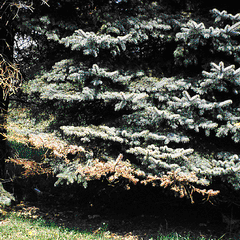The Ortho Home Gardener's Problem Solver
Picea: Canker and Dieback
 Problem
Problem
The needles on the branches nearest the ground turn brown and dry. Occasionally this condition develops first in the upper branches. The needles may drop immediately, or they may remain attached for a year. Eventually the entire branch dies back. Amber-colored pitch usually oozes from the infected area, becoming white as it dries. The infection may spread to the higher branches. To determine if the tree is infected, slice off the bark on a dead branch in the area where the diseased tissue and healthy tissue meet. Small black spore-producing bodies are found beneath the bark.
Analysis
This plant disease is caused by fungus (Cytospora kunzei) that is very destructive to Norway and Colorado blue spruce. The fungus enters the tree at a wound, killing the surrounding healthy tissue. A canker develops and expands through the wood in all directions. When the canker encircles a branch, the branch dies and the needles turn brown. Sap oozes from the dying branch. Eventually small black spore-producing bodies develop in the bark. Older (over fifteen years), weak, or injured trees are most susceptible to the disease.
Solution
Prune off and destroy dead or dying branches well below the infected area, or where the branch meets the trunk. After each cut, sterilize the pruning shears with rubbing alcohol. Do not prune during wet weather. Avoid wounding trees with lawn mowers, tools, and other equipment. Keep trees vigorous by watering during dry spells and fertilizing every few years.
Copyright©1997. Books That Work.
Copyright©1982, 1993, 1997. Monsanto Company.
Visit Books That Work at http://www.btw.com
